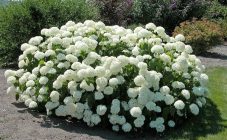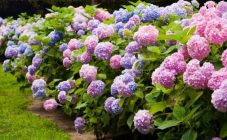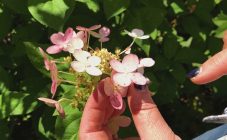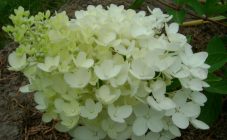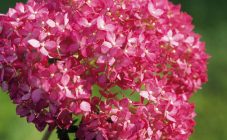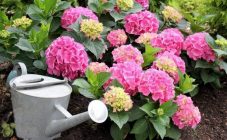Content:
Hydrangea is a beautiful flowering plant that belongs to the Hortensia family. Japan is considered his homeland. In Europe, culture appeared in 1820.
At that time, the plant had only two types: white and scarlet. Since 1900, hydrangea has been bred. The first varieties were not cold-resistant, so the flowers were grown as indoor plants.
reference Information
Most of the plant species are shrubs (their height is 1 - 3 meters), some specimens are small trees, others are lianas.
Crops are deciduous or evergreen. The most widespread are the first species, which belong to plants of a temperate climate.
Hydrangea gets its name from the fusion of two Greek words (hydro - water, angelon - vessel). This means that the seed pods are like jugs or the plants are very fond of moisture.
There is also a legend: in the 18th century, the Frenchman Philibert Commerson, a physician and naturalist, traveled across Japan. The sight of the flowering shrub fascinated him so much that he decided to give the plant the name Hortense in honor of his girlfriend. After all, none of the local residents could answer what the flower was called.
Hydrangea Rough
The description of this variety is short:
- Shrubs have thick branches.
- Large, flat inflorescences are white and lilac. The last specimens are distinguished by small lilac-purple flowers. The flowers are in the middle. Around them are large snow-white flowers.
- The leaves are very decorative, large (length - 35 cm, width - 25 cm). Young leaves are velvety, dark green. At the end of the summer season, they are brown-orange.
- The height of the bush (1.5-2.5 m.). Width (1.2 m.).
- Hydrangea has a high winter hardiness. It can be grown in regions with difficult climatic conditions (including the Moscow region).
- Hydrangea bloom (August-September).
Planting a plant
For the plant, choose a warm, well-protected area from strong winds. It is best to choose shade or partial shade, because the hot midday sun and direct rays of light are bad for the hydrangea.
The soil should be nutritious, neutral, slightly acidified.
It is best to choose a seedling 2 to 3 years old.
The plant can be planted in spring (after the ground has melted) or fall (September).
Landing technology
The planting hole is made in different sizes, depending on the soil:
- light earth (depth - 50 cm, width - 40 cm);
- loam (60 cm x 50 cm);
- clay soils (70 cm x 60 cm).
At the bottom of the pit, chipped brick or crushed stone 15 cm thick is poured.This layer will serve as a drainage.
Fertile soil is laid with a layer of 10 - 20 cm. Humus, peat, mineral fertilizer (50 gr.) Are added to it.
The bushes are planted, leaving a distance of at least 1.5 m between them. The root collar should not be buried. You need to leave it just above the soil level.
The tree is placed in the hole. The roots are carefully spread. Sprinkle with earth, tamp. Water abundantly (use at least 2 - 3 buckets of water).
Care
Rough hydrangeas require a large amount of water. Its deficiency negatively affects the development, flowering of the bush. Therefore, the plant is watered abundantly (3 - 5 buckets of liquid are poured under the bush), often (at least 2 times a week).
In cloudy, rainy weather, irrigation alone will be enough. Mulching with peat (10 cm layer) will help preserve moisture.
The trunks must be loosened at least 2 times per season.
The first two years, the young plant should be allowed to rest. He has enough nutrients used during planting. You just need to care for the hydrangeas as needed.
Two years later, in early spring, the bushes begin to be fed with mineral complexes. During the budding period, plants are fertilized with superphosphate, potassium sulfate, mullein (ratio with water 1:10). To make the branches more durable, hydrangeas are irrigated with a solution of potassium permanganate (2 mg / 10 l of water) every 30 days.
The first couple of years, the bushes do not need to be cut. They need to get stronger. From the third year in the spring (the last days of March - early April), pruning is carried out. The necessary work must be done before the sap flow. To begin with, remove sick, damaged, broken shoots, branches. Then all last year's processes are cut off, retreating by 3 buds.
Despite the excellent frost resistance of rough hydrangea for the winter, the near-trunk zones should be wrapped with dry leaves, sawdust, and covering material.
Reproduction of rough hydrangea
Hydrangeas are bred in several ways:
- Seeds. They are sown in containers (the soil must be moist). The seedlings are covered with glass or plastic wrap. When the soil dries up, it is watered. Shoots appear in three weeks. The seedlings must be grown within two years. Then they are seated in the right places.
- Cuttings. The lateral processes are cut off (they must have large buds). They put it in the water. Cut off the green tops. The processes are divided into fragments. Leave for two hours in Kornevin's solution. Placed in the ground. Cover with banks. Watered 1 - 2 times in 6 - 10 days. After a month, the petioles will take root. When the height of the seedlings is 35 - 45 cm, they are planted.
- By dividing the bush. The plant is moistened, dug up. The roots are cleaned of the earth, washed. Plants are divided into several parts. They are treated with Kornevin. Determined to the selected location.
Diseases, pests
Hydrangea rough has good immunity. However, it can be affected by various diseases, and it is also attacked by insect pests.
- Chlorosis. The leaves brighten, the veins against their background become dark. The reason is the alkalization of the soil. In this case, the plant is treated with a solution of ferrous sulfate (45 g / bucket of water).
- Powdery mildew. The leaves are covered with oily spots. After some time, the spots turn yellow, darken. The bushes are treated with foundation.
If spider mites, aphids, weevils, bugs have settled on hydrangeas, the plants are sprayed with insecticides.
Rough hydrangea is planted in parks, squares, on the streets. Grown in summer cottages, in gardens. Used in landscape design. She decorates flower beds, flower beds, looks great both in single plantings and in group compositions.




